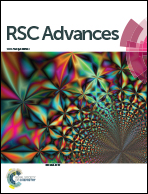Carbon dot reduced Cu2O nanohybrid/hyperbranched epoxy nanocomposite: mechanical, thermal and photocatalytic activity†
Abstract
In the present study a highly tough thermostable hyperbranched epoxy nanocomposite was fabricated by the incorporation of carbon dot reduced Cu2O nanohybrid, which exhibited efficient reusable photocatalytic activity towards the degradation of pesticide under solar light (light intensity: 800–1000 lux). The catalytic efficacy of the above nanohybrid was compared with that of the parent carbon dot. Carbon dot reduced Cu2O nanohybrid particles were prepared by the reduction of cupric acetate solution with carbon dots at 70 °C for 6 h. The formation of nanohybrid (size: 3–4 nm), as well as its nanocomposites with hyperbranched epoxy, was confirmed by FTIR, XRD, Raman and TEM analyses. The significant improvement in the performance in terms of tensile strength (20%), elongation at break (2.5 fold), toughness (3.5 fold) and thermal stability (23 °C) of the pristine epoxy thermoset was observed by the formation of nanocomposite with 1.5 wt% of nanohybrid. The degradation of ethyl paraoxon pesticide was studied under ambient conditions using normal solar light and the changes of concentration with respect to initial were monitored by UV study. Thus, the high performance nanocomposite with photocatalytic attributes has strong potential to be used as a functional thin film material, as well as thermostable reusable photocatalyst.


 Please wait while we load your content...
Please wait while we load your content...